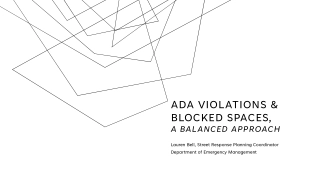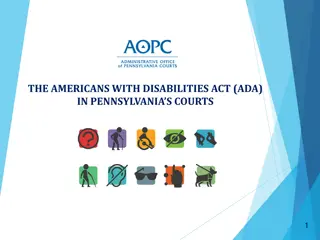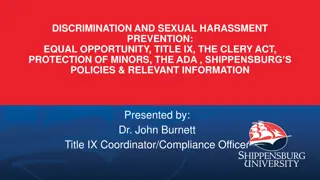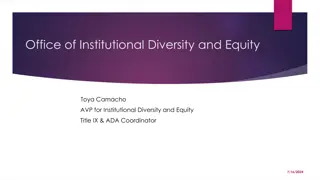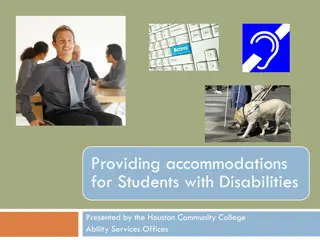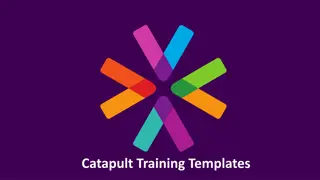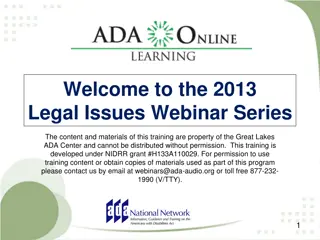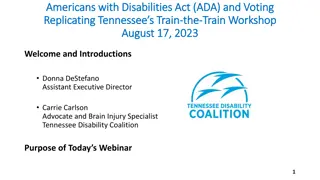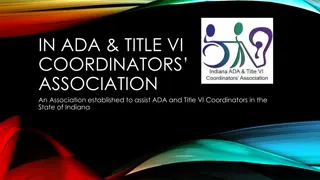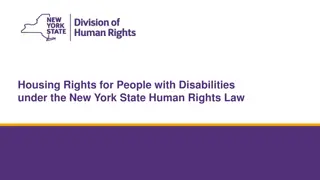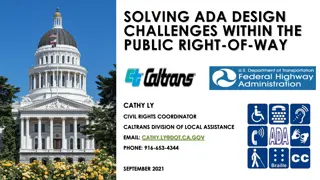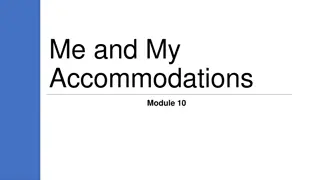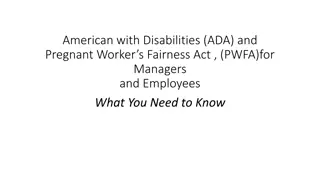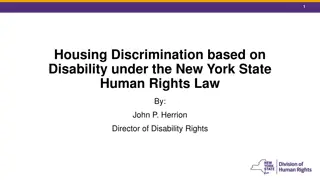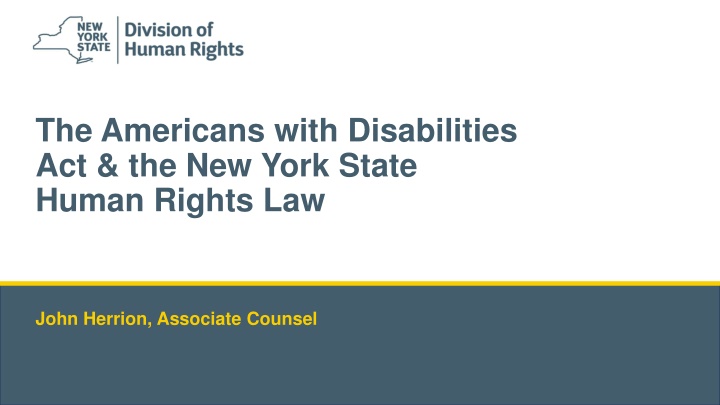
Comparison of Disability Laws in New York: NYSHRL vs. ADA
This presentation by John Herrion, Associate Counsel, compares the New York State Human Rights Law (NYSHRL) and the Americans with Disabilities Act (ADA) in terms of coverage, definitions of disability, and protections for temporary disabilities. Key points include the jurisdiction of each law, the definition of disability under NYSHRL and ADA, and the provisions related to employment. Understanding these distinctions can help individuals choose the appropriate law for addressing discrimination based on disability.
Download Presentation

Please find below an Image/Link to download the presentation.
The content on the website is provided AS IS for your information and personal use only. It may not be sold, licensed, or shared on other websites without obtaining consent from the author. If you encounter any issues during the download, it is possible that the publisher has removed the file from their server.
You are allowed to download the files provided on this website for personal or commercial use, subject to the condition that they are used lawfully. All files are the property of their respective owners.
The content on the website is provided AS IS for your information and personal use only. It may not be sold, licensed, or shared on other websites without obtaining consent from the author.
E N D
Presentation Transcript
The Americans with Disabilities Act & the New York State Human Rights Law John Herrion, Associate Counsel 1
2 What We ll Cover Comparisons & contrasts between the New York State Human Rights Law (NYSHRL) and the Americans with Disabilities Act (ADA). Appropriate selection of which Law to remedy discrimination based on disability. Distinctions related to agencies enforcement. 2
3 The Basics The Americans with Disabilities Act is a federal law that primarily covers employment, state and local government entities, and places of public accommodation The NYS Human Rights Law is a state law that primarily covers employment, places of public accommodation, including state and local government entities and housing. 3
4 Definition of Disability under NYSHRL physical, mental or medical impairment resulting from anatomical, physiological, genetic or neurological conditions which prevents the exercise of a normal bodily function or is demonstrable by medically accepted clinical or laboratory diagnostic technique, or; a record of such an impairment, or; a condition regarded by others as such an impairment. 4
5 Temporary Disabilities A current employee experiencing a temporary disability is protected by the NYSHRL, where the individual will be able to satisfactorily perform the duties of the job after accommodation in the form of a reasonable time for recovery. The NYSHRL requires no more than de minimis accommodations for temporary disabilities in the areas of worksite accessibility, acquisition or modification of equipment, job restructuring or support services for persons with temporarily impaired hearing or vision. 5
6 Definition of Disability under Americans with Disabilities Act (ADA) The ADA defines disability as a substantial limitation of a major life activity. The definition of disability under the NYSHRL is more broadly construed and does not require the impairment to be substantial nor affect a major life activity. 6
7 Employment The employment provisions of the New York State Human Rights (NYSHRL) and the ADA largely mirror one another. One distinction is how many employees are required for jurisdiction. The ADA covers employers with 15 or more employees, while the NYSHRL covers all employers. 7
8 Employment EEOC & NYSHRL The ADA requires that Title I complaints filed against employers first be filed with the EEOC. After investigation, the EEOC issues a right to sue letter, which then allows the matter to be filed in federal court. An individual who wishes to file an employment discrimination complaint under the NYSHRL may do so directly with the NYS Division of Human Rights. 8
9 Employment ADA Title I Statute of Limitations The statute of limitations for filing an ADA Title I complaint with the U.S. EEOC is 180 calendar days from the date of discrimination. However, the deadline can be extended to 300 days if the complaint is also covered by a state or local anti-discrimination law. 9
10 NYSHRL Statute of Limitations The statute of limitations was recently amended under the NYSHRL. FOR ACTS THAT OCCURRED BEFORE 2/15/2024: Complaints must be filed within one year of the most recent act of alleged discrimination. FOR ACTS THAT OCCURRED ON OR AFTER 2/15/2024: Complaints must be filed within three years of the most recent act of alleged discrimination. 10
11 Retaliation - ADA Retaliation is unlawful under the ADA. Retaliation is when an employer takes a negative action against an employee or applicant with a disability because they are exercising their rights. This includes requesting reasonable accommodations. Retaliation is a form of discrimination under the ADA and is prohibited in all three titles of the ADA. 11
12 Retaliation NYSHRL It shall be an unlawful discriminatory practice for any covered entities to retaliate or discriminate against any person because that individual has opposed any practices forbidden under the NYSHRL or because that individual has filed a complaint, testified or assisted in any proceeding under the NYSHRL. 12
13 Reasonable Accommodation - Employment The provisions under the ADA and the NYSHRL covering reasonable accommodation for employees with disabilities largely mirror one another with the exception that the NYSHRL explicitly added pregnancy-related condition to its reasonable accommodation requirement related to employers. 13
14 Interactive Process - ADA EEOC recommends that employers: (1) Analyze the particular job involved and determine its purpose and essential functions; (2) Consult with the individual with a disability to ascertain the precise job-related limitations imposed by the individual's disability and how those limitations could be overcome with a reasonable accommodation; (3) In consultation with the individual to be accommodated, identify potential accommodations and assess the effectiveness each would have in enabling the individual to perform the essential functions of the position; and (4) Consider the preference of the individual to be accommodated and select and implement the accommodation that is most appropriate for both the employee and the employer. 14
15 The Interactive Process - NYSHRL New York State regulations set forth the obligations of both the employer and employee to engage interactively in the reasonable accommodation process. 15
16 The Interactive Process Employer should provide information to applicants and new employees as to their rights about reasonable accommodation of disability, and as to procedures to be followed in requesting reasonable accommodation. 16
17 The Interactive Process Employer has the duty to move forward to consider accommodation once the need for accommodation is known or requested. The employer has the duty to clearly request from the applicant or employee any documentation that is needed. Once an accommodation is under consideration, the employer has the right to medical or other information that is necessary to verify the existence of the disability, or that is necessary for consideration of the accommodation. The employer must maintain the confidentiality of individuals' medical information. 17
18 The Interactive Process Employer has the right to select which reasonable accommodation will be provided, so long as it is effective in meeting the need. 18
19 The Interactive Process Employee has the duty to make the disability and need for accommodation known to the employer and has the right to request an accommodation at any time, even if his/her medical condition has not changed. 19
20 The Interactive Process Employee has the duty to: cooperate with the employer in the consideration and implementation of the requested reasonable accommodation; and cooperate in providing medical or other information that is necessary to verify the existence of the disability or what is necessary for consideration of the accommodation. The employee has a right to have his/her medical information kept confidential. 20
21 Housing The ADA covers housing in limited circumstances related to accessibility for rental offices. The NYSHRL covers housing providers and prohibits them from discriminating against persons with disabilities and requires reasonable accommodation. Intersectionality between NYSHRL & ADA re: Service & Assistance Animals 21
22 Guide, Hearing & Service Dogs Persons with disabilities that use guide, hearing or service dogs that have been professionally trained have significant protections under the NYSHRL to have the dog go where they go.
23 G/H/S Dogs & Assistance Animals - Housing Persons who use G/H/S dogs that are professionally trained are protected to have their dogs live with them. Assistance animals not professionally trained are subject to a reasonable accommodation analysis.
24 Assistance Animals - Housing Persons with disabilities that have a disability related need for an assistance animal can ask a landlord to waive a no pet policy to allow for an assistance animal to live with the individual. Landlord is entitled to medical documentation to support that the person has a disability and that the need for the animal is disability related.
25 Assistance Animals - Housing Landlords are prohibited from making restrictions on the type of animal, breed or size of dog, and from assessing fees for someone who needs an assistance animal because of their disability. Assistance animals are not pets.
26 Assistance Animals FHA & NYSHRL Service Animals ADA & NYSHRL There is a distinction between service animals and assistance animals as covered by the Americans with Disabilities Act (ADA), and the Federal Fair Housing Act and NYS Human Rights Law.
27 Service Animals - ADA The ADA s coverage of service animals applies to places that are open to the public, not your home. Where am I standing?
28 Where am I standing? - In my home. The FHA and NYSHRL cover housing and permit for assistance animals as reasonable accommodations. It can be any type of animal, within reason. It can be an emotional support animal. Housing provider can ask for medical documentation.
29 Where am I standing? - In a place that is open to the public not my home. The ADA and NYSHRL cover places that are open to the public and allow for service animals for persons with disabilities. A service animal can be either a dog or miniature horse. Emotional support is not a covered service. Owner may ask: 1) Is it a service animal? What type of service does it provide? The end.
30 Assistance Animals - Housing Service Animals Public Places Where am I standing?
31 Public Accommodations ADA & NYSHRL The provisions of the ADA and the NYSHRL related to places of public accommodation largely mirror one another. In 2009 the NYSHRL was amended to add Title III protections. Coverage of transportation under the ADA is broader than the NYSHRL. 31
32 Transportation Exclusion - NYSHRL Unlawful to refusal to remove transportation barriers in existing vehicles and rail passenger cars used by an establishment for transporting individuals (not including barriers that can only be removed through the retrofitting of vehicles or rail passenger cars by the installation of a hydraulic or other lift). 32
33 Transportation Exclusion - NYSHRL Public Accommodations provisions of NYSHRL do not apply to any air carrier, the National Railroad Passenger Corporation, or public transportation facilities, vehicles or services owned, leased or operated by the state, a county, city, town or village, or any agency thereof, or by any public benefit corporation or authority. 33
34 Title II of the ADA & the NYSHRL Title II of the ADA covers state and local government entities and prohibits their discrimination on the basis of disabilities. State and local government entities were added to the coverages for places of public accommodation in the NYSHRL. 34
35 Filing a Complaint With DHR The Division of Human Rights has 11 regional offices around the state where information may be obtained and a complaint filed. Complaint forms are also available on the Division s website, dhr.ny.gov. Once completed, they can mailed or dropped off at one of our regional offices. If you have questions, you can reach us by phone: 1-888-392- 3644 . 35
36 Final Orders and Remedies Where the Commissioner finds that discrimination has occurred, remedies may include: o an order to cease the discriminatory policies; o reinstatement to a job, with back pay; o provision of housing, public accommodation or education; o reasonable accommodation; o compensation for monetary losses and mental anguish; o a requirement that training be conducted; o punitive damages; o civil fines and penalties; o attorney s fees. . 36
37 Remedies Distinction Places of Public Accommodation Compensatory damages are available as a remedy for places of public accommodation cases under the NYSHRL. . 37
38 Contact Us! . Call Email Visit Follow @NYSHumanRights on YouTube, Twitter, Facebook, Instagram, Threads, and LinkedIn dhr.ny.gov 888-392-3644 info@dhr.ny.gov 38
39 Contact Info John Herrion, can be contacted at john.herrion@dhr.ny.gov, or 718-741-8332.

